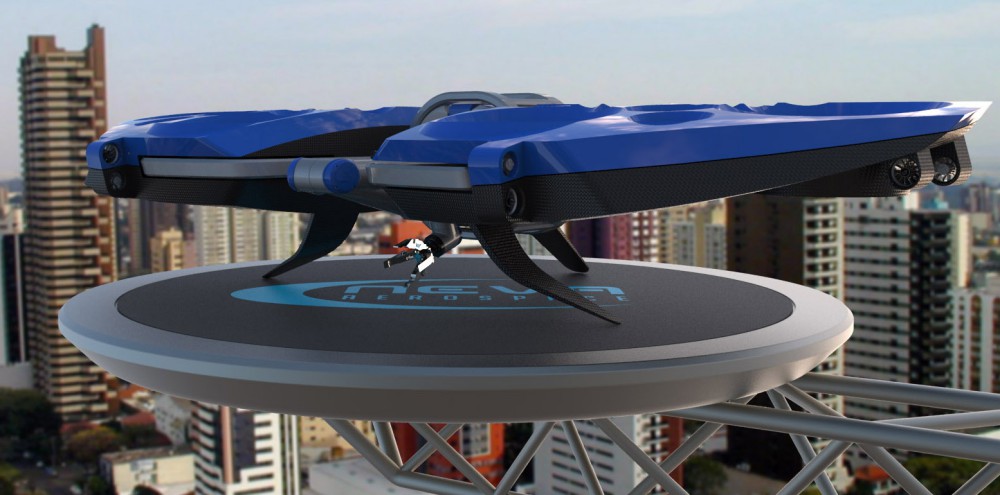Neva Aerospace has announced its SpaceBridge concept – SpaceBridge networks for “Charging and re-provisioning station for electric and hybrid unmanned aerial vehicles” (patent protected), would provide the power platform for wide area operations of aerial electric vehicles, manned (flying cars) or unmanned (drones).
Neva Aerospace has developed underlying propulsion technology that will allow for longer distance, heavier-duty electrical VTOL craft and it already markets modular turbo-drones TM and OEM turbo-fans optimised for VTOL and STOL. Now it has also addressed the key challenge of flight duration with the technologically-viable idea of SpaceBridge recharging stations. (see more below).
“We are confident that we currently offer the only viable technology platform for widespread commercial development of UAVs and flying cars,” says Neva Aerospace Chairman Robert Vergnes.
Neva’s electric air vehicles are fundamentally safer than helicopters or conventional aircraft, due to a technology known as distributed electrical propulsion, which the company has championed and patented since its inception in 2009. Most current day VTOL aircraft (such as the Harrier, the Osprey or many helicopters for example) possess no redundancy in their propulsion systems. This leads to the concept of critical components; when one of these breaks, the aircraft goes down. We cope with this today through meticulous inspection and service schedules and great care in the manufacture of such critical components.
Electric aviation allows a way around the critical component problem: instead of one motor and one set of propellers keeping you flying in VTOL, Neva envisages using typically 20 to 60 independent electric turbines. By also using network solutions for power systems, flight control systems and communication systems, the company is convinced that it can create VTOL aircraft having no critical components. In plain language that means that if something goes wrong – really anything – it just doesn’t compromise the safety of the whole aircraft.
This is especially important in the context of a city-based aerial transportation system – such as the air- taxi. In addition, they can be rather quieter than conventional aircraft and the Neva technology of distributed propulsion makes precision automatic flying to virtually centimetre accuracy possible.
Clearly, aircraft built for reliable, safe, long-range flight will need new power solutions. That is where Spacebridge comes in.
About Spacebridge
SpaceBridge is conceived as an infrastructure network of specialised docking stations catering for electric aerial vehicles, serving any make of aerial vehicle. Stations will be deployed in a variety of locations such as cities or along trajectories connecting cities. Unmanned (UAV) and manned (MAV) aerial vehicles, including Neva’s existing Eole modular drones or future AirQuadOne and AirCab4, will be able to land automatically on Spacebridge docking stations, where battery packs are rapidly swapped before the aircraft continues its journey.
Spacebridge Hubs may be integrated into current airports on constructed on city rooftops. Each hub may provide multiple docking bays, air-bridges and lounges where passengers can embark and disembark. More simple Spacebridge stations (where passengers do not alight, such as would be used to assure intercity transport) consist of a single docking station typically mounted on a tall concrete pylon.
Up until now however, the great problem with suitable electric vehicles has been the intrinsically small flight time. SpaceBridge solves this issue both for inter-city and intra-city transport for countries and municipalities cautious of their resources and environmental impacts.
Neva also envisages the sustainable SpaceBridge concept being applied to many other fields. For example coastal or border surveillance and rescue is often required over great distances and yet even small electric drones cannot fly these distances. Low-cost SpaceBridge recharging stations, coupled for example to solar panels, could solve this problem. Other major applications that the company sees are in agriculture and parcel delivery.
Robert Vergnes, Neva Aerospace chairman and CEO :
“The cost of establishing new conventional city and intercity transport infrastructure and maintaining it, is extremely high today for municipalities and governments. Aerial transport using conventional vehicles requires either new expensive airports to be constructed or very high running cost solutions such as fleets of helicopters to be adopted.
Spacebridge offers an alternative 100% electrical clean and sustainable aerial solution that is ideal for either city or inter-city transport solutions and also for developing countries. Clearly refuelling for fully electrical or hybrid systems will be key to the development of markets for UAVs and MAVs and other VTOL flying cars. So, SpaceBridge TM is a key to unlocking the market.”
Prf. David Brotherton-Ratcliffe, Chief Science Officer explains:
“Current battery technology limits the practical flight time of a compact 4-person all-electric VTOL aerial vehicle to around twenty minutes with reserves. Whilst this flight time can certainly be improved by making the vehicle larger and lighter, performance in terms of speed, flight agility, flight stability and practicality suffers greatly.
“The Spacebridge concept solves this problem by allowing an aircraft to land automatically at intermediate locations along its journey path; at these locations (the Spacebridge stations) the vehicle’s battery is changed automatically (typically within thirty seconds to one minute) before resuming its journey. If the practical range of a given all electric air-taxi is around 30kms with reserves, laying out six Spacebridge stations at a 30km spacing enables you cheaply, rapidly and easily to connect two cities 150kms apart. Spacebridge stations may also be scattered around a city forming the basis for a clean efficient aerial transport network.”
Robert Vergnes added
” Now that we have actionable Intellectual Properties for UAVs and MAVs, we are able to start licencing our sustainable solutions to the automotive and aerospace markets.”
Source: Press Release


